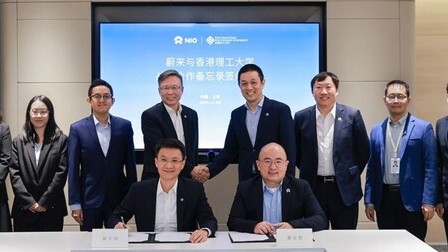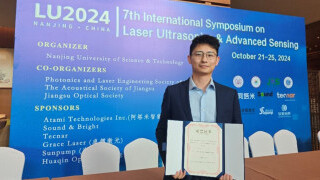Flexible Electronics: Permeable 3D Integrated Electronic Skin in Liquid Metal Circuits and Fibrous Substrates
Other Articles

Advancements in flexible electronic skin technology for enhanced health monitoring and wireless communication.
Study conducted by Prof. Zijian ZHENGand his research team
The development of flexible electronic skins, often referred to as e-skins, represents a significant advancement in the field of health monitoring technology. These innovation mimics the properties of human skin, offering a pliable, stretchable, and lightweight electronic system that can seamlessly conform to the body's contours. The growing demand for such technology is driven by the need for continuous, real-time health monitoring, which is crucial for the early detection and management of various medical conditions. E-skins have the potential to revolutionise healthcare by providing non-invasive, comfortable, and unobtrusive monitoring solutions that can track vital signs such as heart-rate, temperature, and blood pressure, as well as biochemical markers.
Despite their promising applications, the development of flexible electronic skins faces several challenges. One of the primary hurdles is the integration of rigid components with stretchable electronic circuits into a cohesive 3D system that preserves both flexibility and durability. Ensuring reliable performance over extended periods—particularly under the dynamic conditions of daily human activity—presents another significant challenge. Furthermore, the materials used in e-skins need to be permeable and biocompatible to prevent adverse reactions when in contact with human skin. Efficiently powering these devices without compromising their flexibility is also a critical issue. Some previous studies attempted to develop 3D stretchable electronics systems using multi-layered sequential casting of elastomeric films, such as polydimethylsiloxane (PDMS). However, the thick layer (greater than 1mm) of these 3D stacks is relatively less conformable and stretchable, making them less suitable for long-term biocompatibility.
Writing in Nature Electronics, a research team led by Prof. Zijian ZHENG, Chair Professor of Soft Materials and Devices of the Department of Applied Biology and Chemical Technology at The Hong Kong Polytechnic University, presents an innovative approach that utilises liquid metal (LM) circuits and organic stretchable fibrous substrates to achieve a permeable, 3D integrated electronic skin (P3D-eskin) [1]. This work builds upon Zheng’s previous research into fabricating a liquid metal fibre mat [2] which is characterised by high conductivity, ultra-stretchability, and mechanical robustness. By integrating functional electronic components into the fibre mat, the system enables continuous data acquisition, signal processing, and analysis, thus facilitating intervention and wireless communication with a mobile device.
The P3D-eskin is around 0.15 – 0.28mm thick, which consists of four stretchable and permeable layers: a base LM circuit layer, a top LM circuit layer, a paste mask layer bonded with rigid electronic components using a stretchable hybrid liquid metal (hLM) solder, and an encapsulation layer (Figure 1). The base and top LM circuit layers, each of 40–100 μm, are fabricated on a stretchable fibrous mat using photolithography, pattern transfer, and stencil printing. These circuits serve as stretchable antennas, interconnects, pads, and contacts, with vertical electrical connections achieved through LM stretchable vertical interconnect accesses (VIAs). The use of eutectic gallium-based alloys as the LM is crucial due to their high stretchability, low modulus, excellent electrical conductivity, biocompatibility, and patternability.
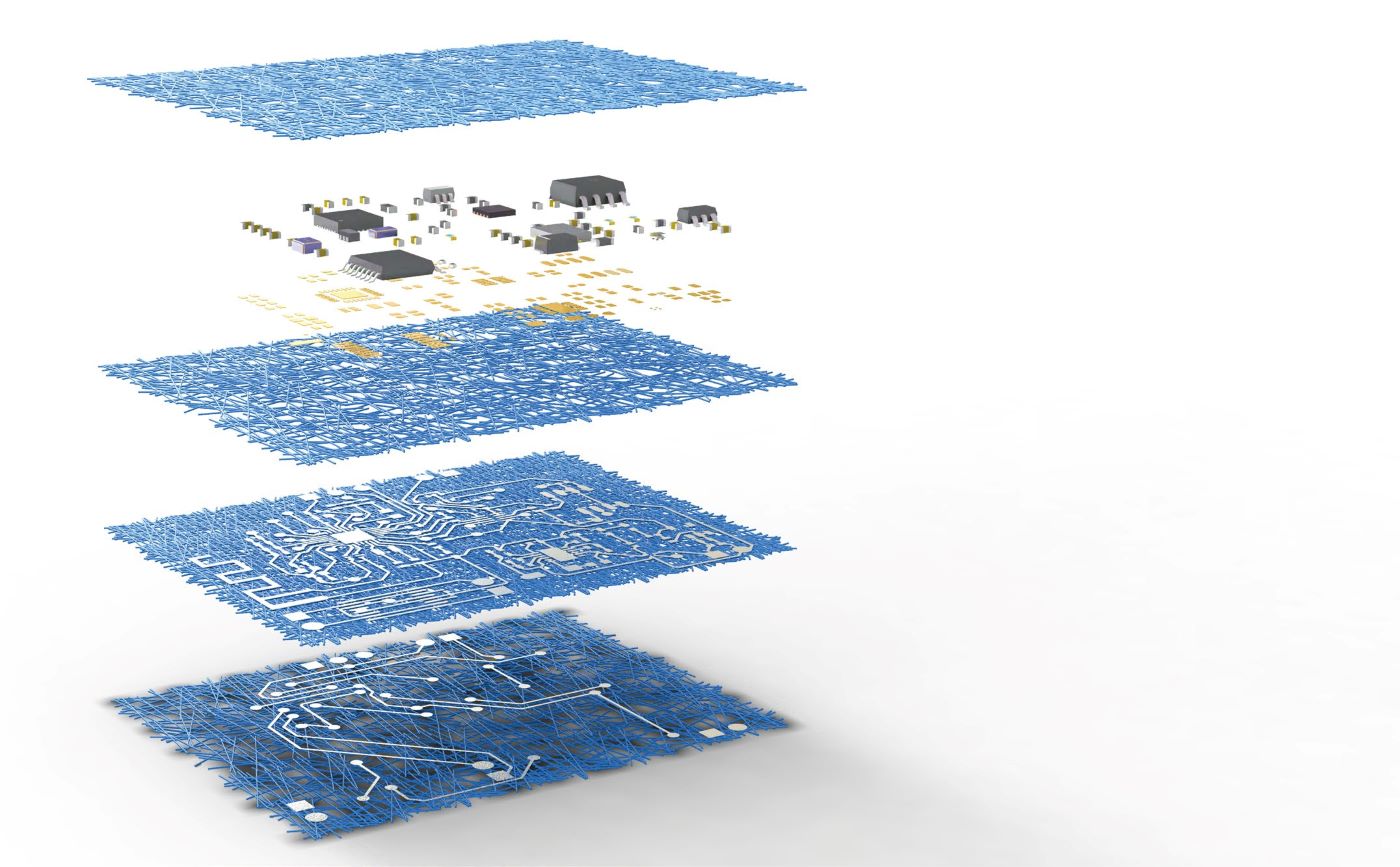
Figure 1. Exploded schematic of a typical P3D-eskin.
Liquid metal (LM) microelectrodes are adopted as the reliable interface between the soft, rough fibre mat substrate and the rigid components. Vertical interconnect accesses (VIAs) are used for interlayer electrical connections. The key components in each layer include an MCU, oscillator, MUX, current mirror, DAC, OP-AMP, HV (20.0 V) and LDO (3.3 V). The dashed lines indicate the distribution and positions of VIAs in the system.
A critical aspect of the P3D-eskin design is the use of hLM solders to ensure reliable 3D electrical interfaces. This involves formulating two types of LM ink—pristine LM and oxidised LM (oLM)—to serve as stretchable solders for the 3D circuit. The pristine LM provides high fluidity but low wettability, while oLM offers better adhesion due to reduced surface tension (Figure 2). Pins of rigid electric components, such as microcontroller units (MCU), LEDs, oscillator, multiplexer (MUX), current mirror, digit-analogue converter (DAC), operational amplifier (OP-AMP), high-voltage module (HV, 20.0 V) and low-droplet regulator (LDO, 3.3 V), are adhered onto the printed oLM pads (Figure 1). The oLM is printed on the paste mask layer made of permeable but waterproof fibrous poly(styrene-block-butadiene-block-styrene) (SBS; 15–30 μm). The hybrid solder combines these properties, reducing stress concentration at the interface between rigid chips and the soft SBS substrate. This results in outstanding interfacial stability, even under large tensile strains, with negligible resistance changes when stretched up to 1,500%. The seamless integration of different layers is achieved through electro-spinning, ensuring no interfacial gaps during stretching or bending.
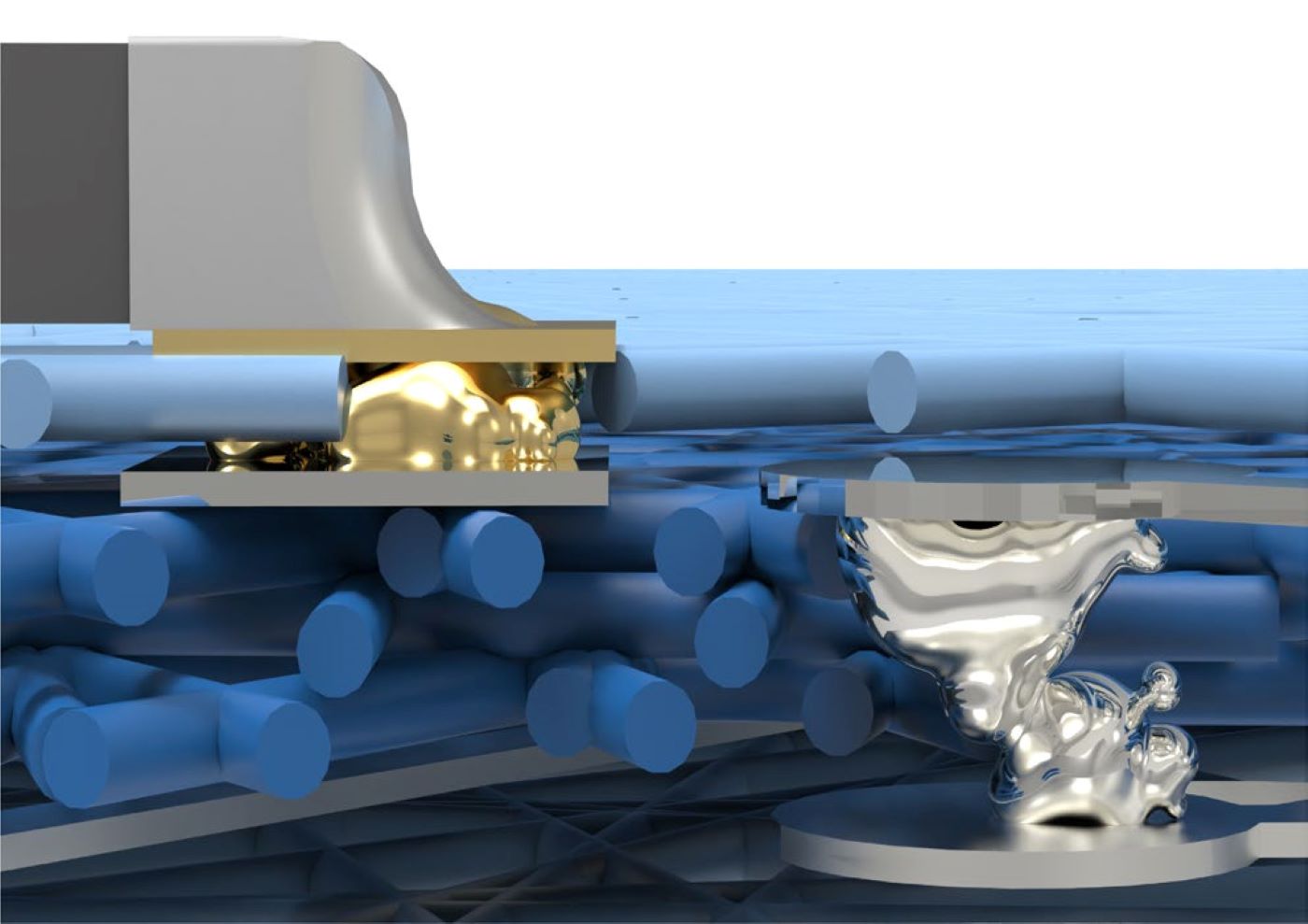
Figure 2. Reliable 3D hybrid interfaces using ultrastretchable hLM solder
Schematic of the 3D electrical connection and interfaces between the rigid IC and ultrastretchable hLM solder. oLM serves as the contact pads, whereas pristine LM serves as the patterned in-plane interconnects, VIAs and additional contact paste.
The encapsulation layer, also made from a thin SBS mat of around 50 μm thick, is electro-spun to cover the entire 3D hybrid electronic circuit. Unlike traditional PDMS-based e-skins, this layer's microporous structure allows air and moisture to pass through while repelling water droplets, achieving both permeability and waterproofness. The air and moisture permeabilities of P3D-eskin reached 177 mm s−1 and 676 g m−2 day−1, which is 15-fold and 44-fold higher than medical tapes and 3-fold and 22-fold higher than commonly used wound dressing, respectively. It prevents sweat accumulation, reducing the risk of skin dampness, allergies, and inflammation.
The P3D-eskin is extremely soft and stretchable, maintaining stable electrical function under a tensile strain of up to 550%. It features a long-range wireless transcutaneous electrostimulation system, equipped with a Bluetooth Low Energy (BLE) 5.1 built-in MCU and a 2.4 GHz BLE LM antenna (Figure 3). This system provides stable wireless control and data transmission over distances of up to 15 metres. The electro-stimulating electrodes generate high-voltage electrical pulses with controlled current intensity, frequency, and duty cycle, delivering electrical stimulation to the user's body. The high permeability of the P3D-eskin ensures no signal drift or electrical failure, even under challenging conditions like steaming. Additionally, a battery-free version of the P3D-eskin utilises near-field communication (NFC) technology, featuring highly flexible and stretchable LM antenna coils (Figure 4). These coils outperform conventional copper coils in terms of design compactness, stretchability, and electromagnetic stability. The NFC P3D-eskin can continuously monitor body temperature during various activities, offering high wearer comfort and biocompatibility.
Figure 3. The stretchability of the P3D-eskin. The material is extremely soft and stretchable, maintaining stable electrical function under a tensile strain of up to 550%.
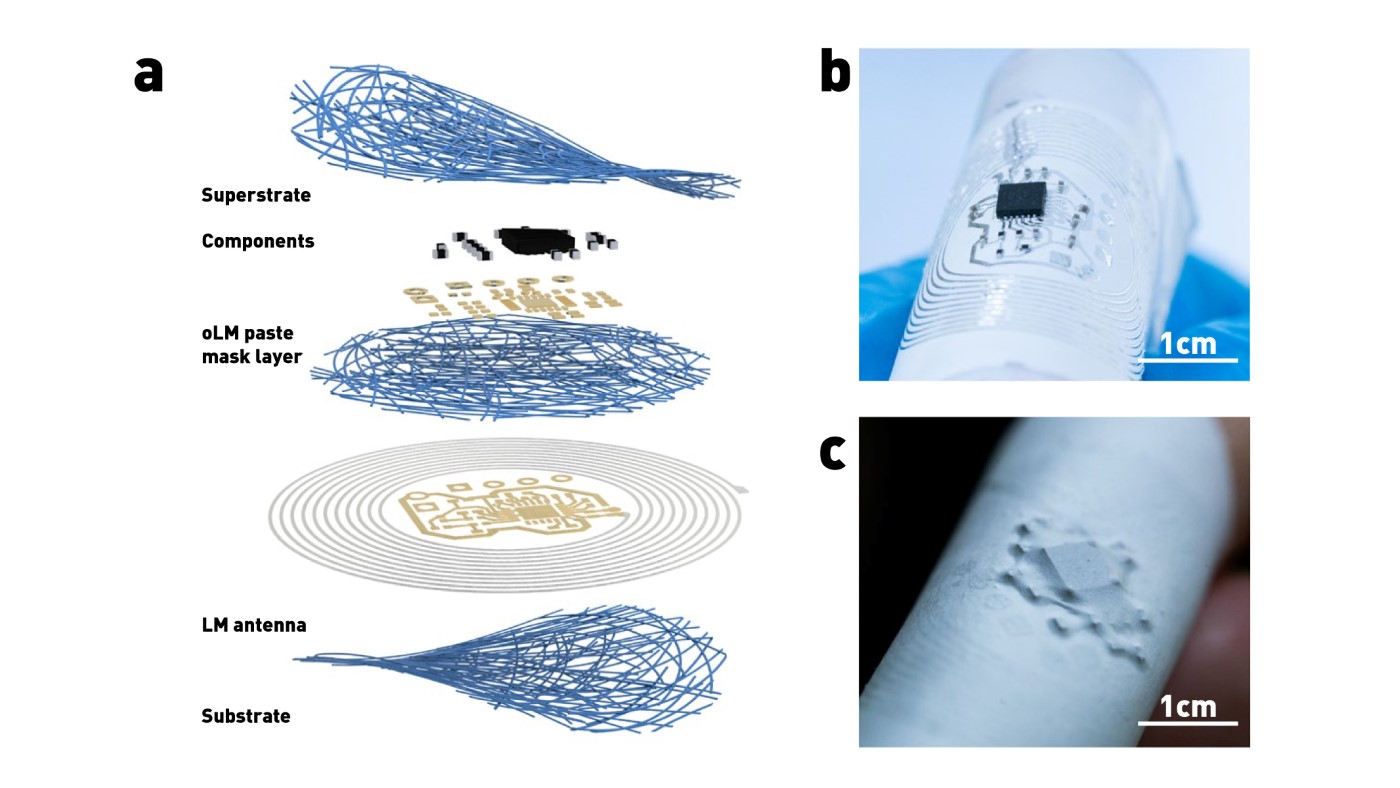
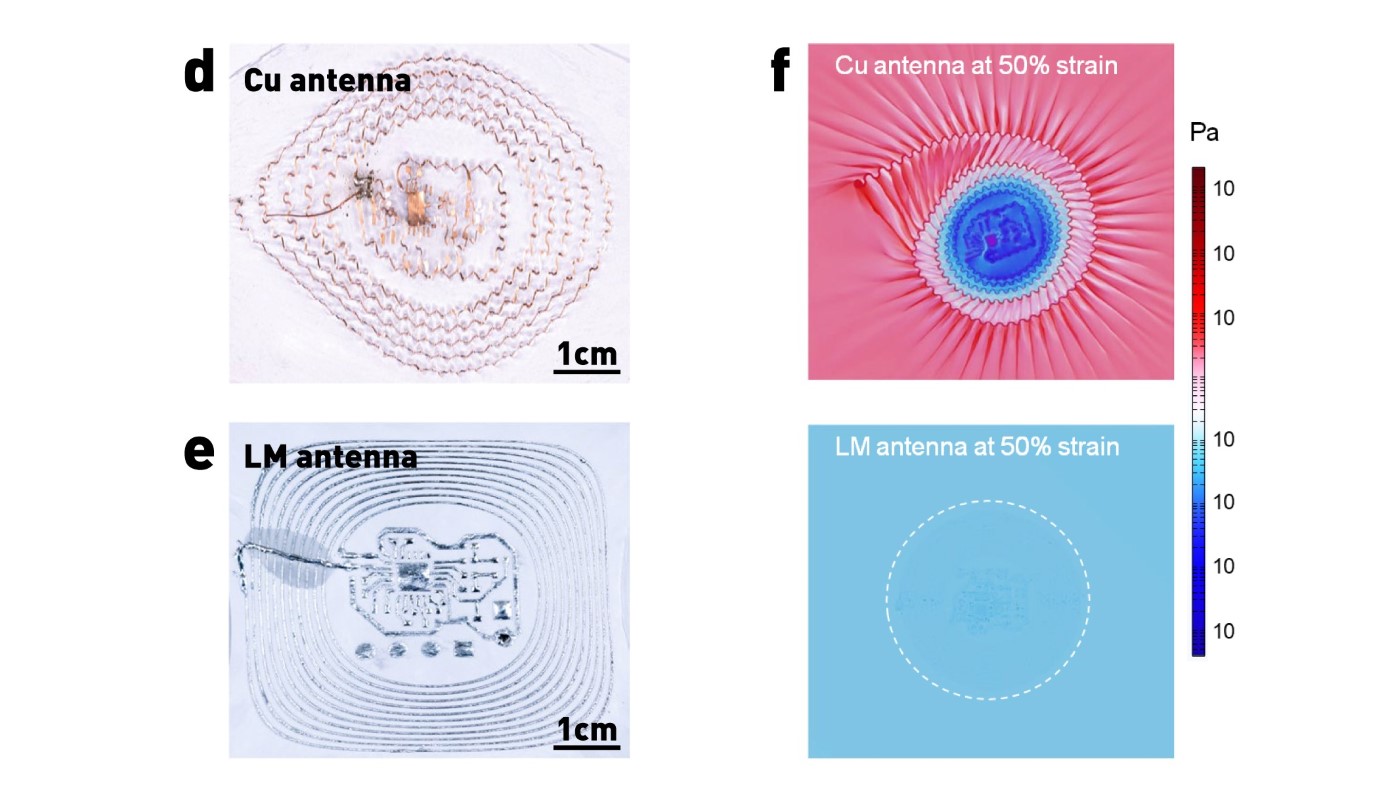
Figure 4. Battery-free stretchable NFC system based on the P3D-eskin platform.
a, Exploded schematic of battery-free P3D-eskins using NFC technology. The system included a stretchable LM antenna, stretchable printed LM microcircuit integrated with microchips (MCU for NFC, analogue–digital converter and sensors) and permeable fibre mats as the encapsulation and substrate. b,c, Digital images of the NFC P3D-eskins before (b) and after (c) the encapsulation of permeable superelastic fibre mat. d,e, Digital images of the stretchable NFC antennas using conventional serpentine Cu coil (d) and intrinsically stretchable LM coil (e). Both antennas are stretched at 50% strain. f, FEA of the stress distribution of stretchable antennas under biaxial stretching (50% strain) using Cu serpentine and intrinsically stretchable LM.
Overall, the P3D-eskin represents a significant advancement in electronic skin technology, exhibiting high softness, durability, fabric-like permeability to air and moisture and sufficient biocompatibility for on-skin attachment for a week. Its innovative design and fabrication techniques enable a wide range of applications in physiological monitoring, wireless communication, and wearable electronics, offering a more comfortable and effective solution for long-term use on the human body.
The research is supported by the RGC Senior Research Fellow Scheme (SRFS2122-5S04), The Hong Kong Polytechnic University (1-ZVQM, 1-BBXR and 1-CD44), the Research Grants Council of the Hong Kong Special Administrative Region (grant nos. RFS2324-1S03, 15304823, 11213721, 11215722, 11211523), City University of Hong Kong (grant nos. 9667221 and 9678274), and the National Natural Science Foundation of China (NSFC) (grant nos. 61421002 and 62122002), as well as in part by the InnoHK Project on Project 2.2—AI-based 3D ultrasound imaging algorithm at the Hong Kong Centre for Cerebro-Cardiovascular Health Engineering (COCHE).
The data source is available at https://www.nature.com/articles/s41928-024-01189-x#Sec19, while the code supporting the findings of this study can be obtained from the corresponding authors upon request.
Prof. Zheng was ranked among the top 2% most-cited scientists worldwide (for career-long) by Stanford University for two consecutive years from 2023 to 2024. He is the Founding Editor-in-Chief of EcoMat, a flagship journal in the area of functional materials for green energy and the environment published by Wiley. In recognizing his outstanding achievements in engineering science and technology, Prof. Zheng was awarded the inaugural RGC Senior Research Fellowship in 2021, and he received the Hong Kong Engineering Science and Technology Award in 2023. He is currently the Associate Director of the Research Institute for Intelligent Wearable Systems, as well as the Associate Director of the University Research Facility in Materials Characterization and Device Fabrication of The Hong Kong Polytechnic University.
| References |
|---|
[1] Zhuang, Q., Yao, K., Zhang, C., Song, X., Zhou, J., Zhang, Y., Huang, Q., Zhou, Y., Yu, X., & Zheng, Z. (2024). Permeable, three-dimensional integrated electronic skins with stretchable hybrid liquid metal solders. Nature Electronics, 7(7), 598–609. https://doi.org/10.1038/s41928-024-01189-x
[2] Ma, Z., Huang, Q., Xu, Q., Zhuang, Q., Zhao, X., Yang, Y., Qiu, H., Yang, Z., Wang, C., Chai, Y., & Zheng, Z. (2021). Permeable superelastic liquid-metal fibre mat enables biocompatible and monolithic stretchable electronics. Nature Materials, 20(6), 859–868. https://doi.org/10.1038/s41563-020-00902-3
 | Prof. Zijian ZHENG Department of Applied Biology and Chemical Technology Associate Director of the Research Institute for Intelligent Wearable Systems Associate Director of the University Research Facility in Materials Characterization and Device Fabrication |



